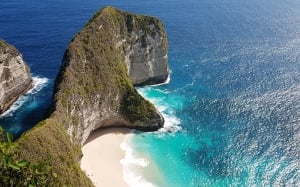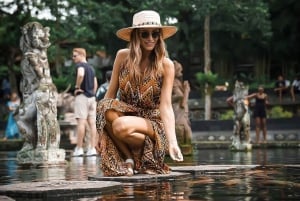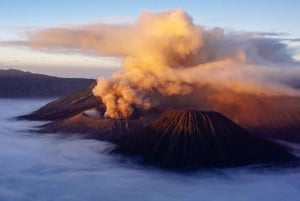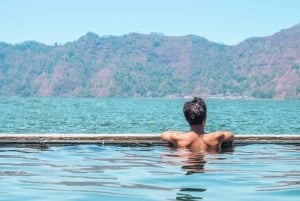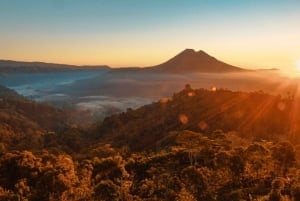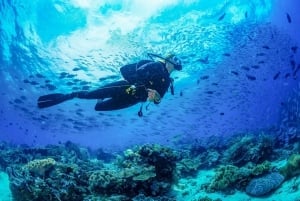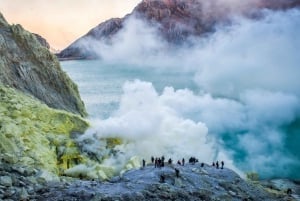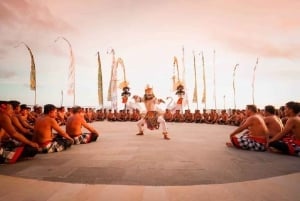Nusa Penida - Nusa Lembongan - Nusa Ceningan
The Channel Islands of Bali
Nusa Penida - Lembongan - Ceningan is a group of islands located 20km off the southeast of Bali island, and part of the Regency of Klungkung. The largest island is Nusa Penida, followed by Nusa Lembongan, with little Nusa Ceningan lying between the two. The climate is much like Bali, with the rainy season November to March and the dry season April to October. Average temperature is 28º-30ºC, with annual rainfall of approximately 1,000 mm - although Nusa Penida is drier than the smaller islands and has a serious water problem. That is probably why there only 42 banjars on Nusa Penida, with a total population of 45,000.
Local inhabitants live mainly by fishing and seaweed production. Almost all are Hindus, carrying out their daily rituals and worship as on Bali - including colourful processions of fruit-carrying women on festive occasions.
Diving in the Channel
Nusa Penida-Lembongan are renowned by divers around the world because the surrounding waters have enormous spreads of coral reefs, and clear vision most of the year. As a result, many marine photographers come to capture the big fish like manta rays or sunfish through their lenses. Whale sharks are often seen, as well as an array of smaller fish - numbering around 576 species. Coral species number 296. There are eight seagrass species cultivated in special "sea farms" and sold as food ingredients. Divers in the areas are warned to be aware of the variable currents, which require strong swimming ability.
Nusa Lembongan is a lovely tropical island, measuring only four by three km and ringed with mangrove swamps, palms and white sandy beaches. No hawkers venture over here, nor are there cars to spoil the idyllic atmosphere and scenery. There are just two villages on Nusa Lembongan: Lembongan Village and Jungut Batu Village, with a total of 5,000 inhabitants. There is motorcycle traffic between the two villages and it is easy to get a bike ride for a couple of thousand Rupiahs. There is a suspension bridge between Lembongan and Celingan, used by pedestrians and motor bikes.
The inhabitants' main occupations are fishing and seaweed farming, though some make a living with their boats, ferrying divers or surfers to their chosen destinations around the island, then making the return journey at the end of a day of fun. Others work for the companies running floating diving pontoons like the Bali Hai, Waka Nusa, Bounty Cruise and SailSensation, or at the accommodations at High Tide Huts, Waka Nusa Resort, Nusa Lembongan Resort, and the island's villas.
Nusa Ceningan is located in between the other two islands, and is the smallest of the three. Here you can stay at a local house and try the traditional cuisine. Guides will charter a fishing boat for you, or take you to dive and snorkel in the blue ocean with its exquisite variety of fishes and corals. Most people on this tiny island are seaweed farmers.
Nusa Penida is a relatively poor island. The lack of fresh water makes rice farming impossible, and the soil is quite shallow. The southern end of the island is dominated by high cliffs with a flat, dry plateau rising to 500m above sea level. Beautiful views of Bali are enjoyed from here by the few who make the trek. Originally Nusa Penida was the Alcatraz or Robben Island of Bali, used as a prison for convicts by the Gelgel Dynasty in the 18th Century.
Most of the population are Hindus, but the culture is quite different, with local variations of dance and music, architecture and crafts. The language is an old form of Balinese, not used anywhere else. According to legend, Nusa Penida is home to a mythical and infamous figure, Jero Gede Macaling, who frequently sends his invisible helpers to the southeast part of Bali to spread drought, famine, rats and pestilence. Macaling is only spoken of with a low voice, and then mentioned with the honorable title Beliau. In return for certain rituals, Macaling is believed to protect the people.
Nusa Penida, has few tourist facilities, but you will find simple accommodations. The two important villages are Sampalan and Toyapakeh. From Toyapakeh there is a boat leaving to and from Nusa Lembongan, and a ferry from Padangbai. You can travel around the island with a bemo or a motorbike, but the roads are quite rough. Even so, the scenery can be very interesting.
There are several Hindu temples on the island: Penataran Ped Temple in Ped Village, Goa Giri Putri Temple at Suana Village and Puncak Mundi Templ at Klumpu Village. When visiting, be respectful and always heed local advice. No semi-naked tops or legs. Wear the covering supplied at a nominal price.
To get to Crystal Bay, take the only road which heads west from the main road at Sakti village and keep going until you reach the gleaming white sand beach at Banjar Penida, facing Nusa Ceningan. Perfectly clear waters mean excellent snorkelling. It's a lovely beach and a great place for a picnic; truly an idyllic spot, which you are likely to have to yourself, aside from the odd local villager or diveboat offshore.
Marine Protection Area
In 2010, Nusa Penida was established as an MPA of 20,057 hectares, under the district of Klungkung. Nusa Penida attracts 200,000 tourists each year, so the programme was instituted, under the auspices of Coral Triangle Centre, which trains marine resource managers and educates all groups that interact with coastlines and reefs within the Coral Triangle. The objective for Nusa Penida MPA is to protect the marine biodiversity of the area, sustaining fisheries, marine tourism and the welfare of the local communities. Marine biologists may be interested in the website.
Diving sites: Penida Bay, Manta Point, Batu Meling, Batu Lumbung, Batu Abah, Toyapakeh and Malibu Point. The boatsmen know every spot, and what you are liable see on your day out. Other sites include Lembongan Point and Blue Corner.
Surfing: The Nusa Penida region is visited by crazy surfers seeking way-out places to surf - spots like Lacerations and Shipwreck. Surfer or not, you're sure to enjoy the breathtaking views. Check surf spots here.
Nusa Penida has some great hills and cliffs to climb, with amazing vistas at their tops.
Getting to the islands: There is a ferry from Padangbai to Toyapakeh (3.5 hrs) or fast boats from Sanur Beach and Benoa Harbour. Of course one could book an all-in day trip, or a three-day package with stay-over, with one of the companies servicing this island group. See listings of Diving Companies and Boat Services on this website.
Scoot Fast Cruises offers a 'round-trip' ticket from Sanur, visiting Nusa Lembongan for a few days, then the Gili Islands, then Lombok, then back to Sanur. No extra charge for stop-overs but they must be booked in advance due to passenger numbers.
____________________________________________________________________________________________________


